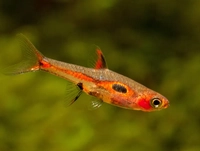

Product Details

Size
1cm - 1.5cm
"Discover the vibrant Strawberry Rasbora (Boraras Naeva)! These tiny, red fish bring color and charm to small aquariums with their lively presence."
Overview: The strawberry Rasbora (Boraras Naeva), is a small and captivating freshwater fish native to the slow-moving waters and peat swamps of Southeast Asia, particularly in Thailand and Malaysia. These fish are highly prized for their intense red coloration and peaceful demeanor, making them a popular choice among aquarists who appreciate nano fish and planted tanks. Despite their diminutive size, Mosquito Rasboras are resilient and active, adding a burst of color and energy to any well-maintained aquarium.
Appearance:
- Coloration: Mosquito Rasboras are known for their vibrant red-orange bodies that shimmer under aquarium lighting, complemented by a silver-white abdomen. They also exhibit a subtle iridescence, especially in males during breeding displays.
- Body Shape: They have a streamlined and slender body with a slightly forked caudal fin and a small, upturned mouth adapted for feeding near the water's surface.
- Size: These rasboras are one of the smallest in the hobby, typically reaching a maximum size of around 0.6 inches (1.5 cm).
Water Conditions: To thrive, Mosquito Rasboras require specific water conditions that mimic their natural habitat:
- Temperature: 72-82°F (22-28°C).
- pH Range: 5.0-7.0.
- Water Hardness: 2-10 dGH.
- Tank Size: Due to their small size and shoaling nature, a tank of at least 5 gallons is suitable for a small group. However, larger tanks provide more stability and swimming space.
Tank Setup: Creating an ideal habitat for your Mosquito Rasboras involves careful planning and consideration:
- Substrate: Use dark-colored fine gravel or sandy substrate to simulate their natural environment and bring out their vibrant colors.
- Decor: Provide plenty of dense vegetation such as Java moss, small-leaved plants like Anubias or Cryptocoryne, and floating plants to create shaded areas and refuge spots. Driftwood and leaf litter can also enhance their habitat.
- Filtration: Gentle filtration is recommended to avoid strong currents that can stress these small fish. A sponge filter or a low-flow hang-on-back filter with adjustable flow is ideal.
- Lighting: Use subdued lighting to mimic the dimly lit conditions of their natural habitats, which helps reduce stress and enhances their coloration.
Tank Mates: Mosquito Rasboras are peaceful and best kept with other small, non-aggressive fish:
- Compatible Species: Ideal tank mates include other small rasboras, small tetras (such as Ember Tetras or Neon Tetras), dwarf shrimp (like Cherry Shrimp), and small peaceful bottom-dwelling fish like Corydoras catfish.
- Incompatible Species: Avoid keeping them with larger or aggressive fish that may intimidate or prey on them. Also, avoid fin-nipping species that could harm their delicate fins.
Feeding Habit: Mosquito Rasboras are omnivorous and primarily feed on small invertebrates and plant matter in the wild. Provide a balanced diet to maintain their health and vibrant colors:
- Staple Diet: High-quality micro pellet or flake food suitable for small tropical fish.
- Supplements: Offer live or frozen foods such as daphnia, brine shrimp, and micro worms to supplement their diet and enhance their coloration.
- Feeding Frequency: Feed small portions 2-3 times daily, ensuring they consume the food within a few minutes to prevent overfeeding and maintain water quality.
Care and Maintenance: Regular care and maintenance are crucial for the well-being of your Mosquito Rasboras:
- Water Changes: Perform regular water changes of 20-30% weekly to maintain water quality and remove waste buildup.
- Health Monitoring: Monitor for signs of disease or stress, such as loss of color, lethargy, or abnormal swimming behaviors. Quarantine new fish before introducing them to the main tank.
- Behavioral Observation: Watch their behavior daily. Healthy Mosquito Rasboras are active shoalers, swimming in the middle to upper levels of the aquarium and exploring their surroundings.
Breeding: Breeding Mosquito Rasboras in captivity is possible but may require specific conditions:
- Pair Selection: Choose healthy and mature individuals displaying vibrant colors and good overall condition.
- Breeding Setup: Set up a separate breeding tank with dense vegetation and gentle filtration. Condition the fish with live and frozen foods to induce spawning.
- Spawning Process: The female will scatter adhesive eggs among fine-leaved plants or on the substrate. After spawning, remove the adults to prevent them from consuming the eggs.
- Fry Care: Fry hatch within 24-36 hours and become free-swimming shortly after. Feed them infusoria or commercial liquid fry food until they are large enough to accept baby brine shrimp or finely crushed flake food.
Strawberry Rasbora (Boraras Naevus)
Product Options
20 pieces
Delivery
Quantity
 FishyHub Livestock SG
FishyHub Livestock SG Aquarium Fishes, Tanks & Supplies From FishyHub Livestock SG


 SG
SG



